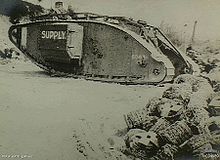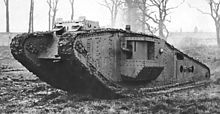- Mark IV tank
-
Mark IV 
Mark IV male with unditching beam deployedType Heavy tank Place of origin  United Kingdom
United KingdomService history Used by British Army Wars First World War Production history Designer Major Gordon Wilson Manufacturer see text Unit cost about £5,000 [1] Produced May 1917 - end 1918 Number built 1,220 Specifications Weight 29 tons (28.4 tonnes), Female: 27 tons (27.4 tonnes) Length 8.05 m (26 ft 5 in) Width Male: 4.12 m (13 ft 6 in) Crew 8 Armour 0.25– 0.47 inches (6.1–12 mm) Main
armamentMale: Two 6 pdr 6 cwt QF with 332 rounds
Female: five .303 Lewis gunsSecondary
armamentMale: Three .303 in Lewis guns Engine Daimler, 6-cylinder in-line
105 bhp at 1,000 rpmTransmission Primary: 2 Forward, 1 Reverse
Secondary - 2 speedFuel capacity 70 Imperial gallons Operational
range35 mi (56 km) Speed 4 mph (6.4 km/h) The British Mark IV tank was a British tank of the First World War. Introduced in 1917, it benefitted from significant developments on the first British tank the intervening designs being small batches used for training. The major improvements were in armour, the re-siting of the fuel tank and easier transportation. A total of 1,220 were built: 420 "Males", 595 "Females" and 205 Tank Tenders (unarmed vehicles used to carry supplies).
The Mark IV was first used in mid 1917 at the battle of Messines Ridge. They remained in service to the end of the war.
Contents
Development
The director of the Tank Supply Department, Albert Gerald Stern, first intended to fit the Mark IV with a new engine and transmission. Production of battle tanks was halted until the new design was ready, necessitating the use of the Mark II and III as interim training tanks. He failed however to complete development soon enough to start production in time to have 200 tanks ready for the promised date of 1 April 1917. He was ultimately forced to take a Mark IV into production in May 1917 that was only slightly different from the Mark I.
The Mark IV Male carried three Lewis machine guns - one in the hull front and two in the sponsons[nb 1] - as well as the two sponson guns (now shorter barrelled QF 6 pdr 6 cwt guns). The Female had five machine guns. Two of the machine guns were operated by the gun loaders.
The decision to standardize on the Lewis gun was due to the space available within the tanks. Despite its vulnerable barrel and a tendency to overheat or foul after prolonged firing, the Lewis used compact drum magazines which could hold up to 96 rounds. The Hotchkiss was fed from a rigid strip which was trimmed down to only 14 rounds for tank use; no sooner had the machine gunner guided the fall of shot onto the target then it was time to change the strip and the process repeated.[2] It was not until a flexible 50 round strip was fully developed in May 1917 that the Hotchkiss would become the standard machine gun for tanks again. The changes caused delays - adapting the design for the bulky Lewis cooling barrel - and later problems when the Hotchkiss strips had to be stored in positions designed for Lewis gun magazines.[2]
This tank introduced the use of the fascine, a bundle of brushwood, bound with chains, about 10 ft (3.0 m) long and 4.5 ft (1.4 m) in diameter carried on the front. It was dropped into trenches to allow the tank to more easily cross over.[3]
A large number of these tanks were also used for development work. In an attempt to improve trench-crossing capability, the tadpole tail was introduced, an extension to the rear track horns. However, it proved insufficiently rigid and does not appear to have been used in combat. Other experimental versions tested radios, mortars placed between the rear horns, and recovery cranes. Some of these devices were later used on operational tanks. Mark IVs were also the first tanks fitted with unditching beams by field workshops. A large wooden beam, reinforced with sheet metal, was stored across the top of the tank on a set of parallel rails. If the tank became stuck, the beam was attached to the tracks (often under fire) and then dragged beneath the vehicle, providing grip.


Unarmed supply tank variant going up to the line at Villers-Bretonneux, August 1918 - Crew: 8
- Combat Weight: Male: 28 tons (28.4 tonnes) - Female: 27 tons (27.4 tonnes)
- Armour: .25–.47 in (6.1–12 mm)
- Armament
- Three MG and two 6-pdrs (Male), Five .303 Lewis MG (Female)
- Ammo storage
- 6 pounder: 180 HE rounds and remainder Case
Production
The Mark IV was built by six different manufacturers: Metropolitan (the majority builder), Fosters of Lincoln, Armstrong-Whitworth, Coventry Ordnance Works, William Beardmore and Company and Mirrlees, Watson & Co., with the main production being in 1917.
The first order was placed for 1,000 tanks with Metropolitan in August 1916. It was subsequently cancelled, and reinstated, and then modified between August and December 1916. The other manufacturers, contracted for no more than 100 tanks each, were largely immune to the conflict between Stern and the War Office.[4]
Service
The Mark IV was used at the Messines Ridge when 62 tanks were used on 7 June 1917. They outran their infantry on the broken up but dry terrain. By comparison, in the Third Ypres from the 31 July when the preliminary 24-day long barrage destroyed all drainage and there was heavy rain, the tanks found it heavy going and contributed little; those that sank into the swampy ground, were immobilized and easy targets for enemy artillery.[5]
Nearly 460 Mark IV tanks were used during the Battle of Cambrai in November 1917, showing that a large concentration of tanks could quickly overcome even the most sophisticated trench system.
In the aftermath of the German Spring Offensive on the western front, the first tank-to-tank battle was between Mk IV tanks and German A7Vs in the Second Battle of Villers-Bretonneux in April 1918.[nb 2]
About forty captured Mark IVs were employed by the Germans as Beutepanzer with a crew of twelve. (The German word Beute means "loot" or "booty".) Some of these had their six pounders replaced by a German equivalent.[6]
The last Mark IV to see service was Excellent, a Mark IV male retained by the naval gunnery school on Whale Island, HMS Excellent. In the early years of the Second World War it was restored to operational status and driven to the mainland, where its new career was allegedly brought to an early end after a number of cars were damaged.
Surviving vehicles
Seven Mark IVs survive.
- A Mark IV Female, F4: Flirt II, which fought at the Battle of Cambrai, is at the Museum of Lincolnshire Life, Lincoln, England. A local company, William Foster & Co., manufactured the first tanks.
- A Mark IV Female is preserved at Ashford in Kent. This is one of many that were presented for display to towns and cities in Britain after the war; most were scrapped in the 1920s and 1930s.
- The Royal Museum of the Army in Brussels has a Male Mark IV tank, the Lodestar III, still in original colours.
- A Mark IV Female, Grit, is displayed in the ANZAC hall at the Australian War Memorial.
- In 1999, a Mark IV Female, D51: Deborah, was excavated at the village of Flesquières in France. It had been knocked out by shell-fire at the Battle of Cambrai (1917) and subsequently buried when used to fill a crater. Work is underway on its restoration.[7]
- A Mark IV Male, Excellent, is displayed at Bovington. After World War I, this tank was presented by the army to HMS Excellent, a Royal Navy shore establishment where some tank crewmen were trained. During World War II, it was made operational again for service with the Home Guard when German invasion threatened in 1940.[8] It is still maintained in working order[9].
- Mark IV Female Liberty: displayed at United States Army Ordnance Museum, Aberdeen, Maryland. Originally named Britannia, this tank took part in the Battle of Arras where it penetrated the German trench lines, destroyed four machine gun positions, helped take 395 prisoners and repulse two German counter-attacks. The tank and her crew were afterwards sent to the US to help sell War bonds. Renamed Liberty, the tank joined the Ordnance Museum collection in 1919. After decades of exposure to the elements it is in poor condition, but about to undergo restoration.[10]
See also
- Mark V tank
Citations and Notes
- Notes
- ^ A spare Lewis gun was carried on board
- ^ part of the Battle of the Lys
- Citations
- ^ Glanfield, Devil's Chariots, Appendix 3
- ^ a b Glanfield, Devil's Chariots, p.169
- ^ "Great Britain's Heavy Tanks". mailer.fsu.edu. http://mailer.fsu.edu/~akirk/tanks/GreatBritain/BritishHeavyTanks.html. Retrieved 2009-02-21.
- ^ Glanfield, Devil's Chariots, Appendix 2
- ^ Glanfield, Devil's Chariots, pp.198-200
- ^ Tanks and trenches: First hand accounts of tank warfare in the first world war. Alan Sutton publishing Ltd. 1994. p. 204. ISBN 0750903465.
- ^ http://www.tank-cambrai.com/pages/indexpag.html
- ^ Fletcher (2007)
- ^ "Tank Mark IV (Male) (E1972.63)". tankmuseum.org. http://www.tankmuseum.org/ixbin/indexplus?_IXSS_=_IXMENU_%3dVehicles%26ALL%3d2324%26_IXACTION_%3dsummary%26%252asform%3d%252fsearch_form%252fbovtm_combined%26TYPE%3darticle%26_IXFPFX_%3dtemplates%252fsummary%252f&_IXFIRST_=1&_IXSPFX_=templates/full/tvod/t&_IXMAXHITS_=1&submit-button=summary&_IXSESSION_=&_IXMENU_=Vehicles. Retrieved 2009-02-02.
- ^ Atwater, W. F.; Hand, S. D.; Hardin, M. J.; Edwards, E. W.; Chamsine, G., The Measurement and Modeling of a World War I Mark IV Tank Using CLR and CCD Camera/Line Scanning Systems in an Outside Environment, Service Metrology Case Studies, http://metrology.survice.com/mark_4_tank.pdf
References
- Fletcher, David (2007). British Mark IV Tank. Osprey Publishing. ISBN 9781846030826.
- Fletcher, David (2001). The British Tanks, 1915–19. Crowood Press. ISBN 1861264003.
External links
- YouTube video clips
- Headquarters, Tank Corps, December 1, 1917, British Army : "Instructions for the training of the Tank Corps in France". Includes Mk IV & V tank specifications.
- Archaeological discovery: the Mark IV tank of Flesquières (Battle of Cambrai 1917)
- A site dedicated to listing all the British tanks that fought in World War one
- List
- Category
British - Mks I, II, III
- Mk IV
- Mk V
- Mk VI
- Mark VII
- Mk VIII
- Mk IX
- Medium Mk A "Whippet"
- Medium Mk B
- Medium Mk C
- Little Willie
- Flying Elephant
- Killen-Strait Amoured Tractor
- Lancelot De Mole's proposal* (1912)
French - Schneider CA1
- St Chamond
- Renault FT-17
- Breton-Prétot machine
- Boirault machine
- Frot-Laffly landship
- Souain prototype
- Levavasseur* (1903)
German Austrian - Günther Burstyn's Motorgeschütz* (1911)
Italian American - Holt Gas-Electric
- Skeleton tank
- Steam tank
- Steam Wheel Tank
- Three-wheeled steam tank
Russian Categories:- Tanks of World War I
- World War I tanks of the United Kingdom
Wikimedia Foundation. 2010.

